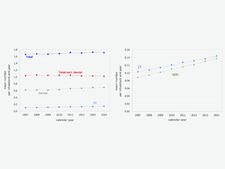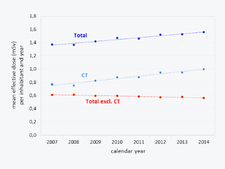-
Topics
subnavigation
Topics
Electromagnetic fields
- What are electromagnetic fields?
- Static and low-frequency fields
- Radiation protection relating to the expansion of the national grid
- High-frequency fields
- Radiation protection in mobile communication
Optical radiation
Ionising radiation
- What is ionising radiation?
- Radioactivity in the environment
- Applications in medicine
- Applications in daily life and in technology
- Effects
- What are the effects of radiation?
- Effects of selected radioactive materials
- Consequences of a radiation accident
- Cancer and leukaemia
- Genetic radiation effects
- Individual radiosensitivity
- Epidemiology of radiation-induced diseases
- Ionising radiation: positive effects?
- Risk estimation and assessment
- Radiation protection
- Nuclear accident management
- Service offers
-
The BfS
subnavigation
The BfS
- About us
- Science and research
- Laws and regulations
- BfS Topics in the Bundestag
- Links
X-ray diagnostics: Frequency and radiation exposure
- The number of X-ray examinations performed as well as the related radiation exposure incurred by the general population in Germany are regularly assessed.
- These data are annually recorded, analysed and evaluated.
- In 2014, approximately 140 Million X-ray procedures were performed (excluding dentals: about 83 Millions).
X-ray examinations always involve some, albeit low, radiation risk. Therefore, the number of examinations performed as well as the related radiation exposure incurred by the general population in Germany are regularly assessed. These data are annually recorded, analysed and evaluated.
How is the frequency of X-ray examinations estimated?
When physicians’ services are billed, reference is made to specific codes of reimbursement catalogues. These codes describe all services provided by the physician, including radiological procedures. They are well suited to estimate the frequency of X-ray examinations, since approximately 98 per cent of the general population in Germany have statutory or private full-cover health insurance. The most important sources for X-ray frequency estimates, therefore, are the health insurance companies.
For inpatients, valid data on hospital statistics published by the Federal Office of Statistics are available since 2007. Further, data from research studies are included.
How is the radiation exposure from X-ray diagnostics estimated?
To estimate the level of collective effective dose (collective dose), the frequency of each type of examination is multiplied by the corresponding estimated mean effective dose from that type of examination, and the products obtained for each type of examination are added up.
The mean effective dose per caput is obtained accounting for the annual total number of German inhabitants.
Results of the present evaluation

![]() Frequency of X-ray examinations and of CT / MRT examinations in Germany
Frequency of X-ray examinations and of CT / MRT examinations in Germany
In 2014, approximately 140 Million X-ray procedures were performed (excluding dentals: about 83 Millions). The frequency of X-ray examinations in Germany almost constantly amounted to about 1.7 examinations per inhabitant and year during 2007 and 2014 (Figure above).
Dental X-ray examinations
The frequency of dental X-ray examinations increased from about 0.6 examinations per caput and year in 2007 to about 0.7 in 2014 (Figure above), i.e. to about 40 per cent of the total number of X-ray examinations in 2014 (median Figure).
Other conventional X-ray examinations

![]() Contribution of various examination types to total frequency (left) and to collective effective dose (right) in 2014
Contribution of various examination types to total frequency (left) and to collective effective dose (right) in 2014
Apart from dental examinations, X-rays of the skeleton (that is, skull, shoulder girdle, spine, pelvic girdle, limbs) and chest (thorax) accounted for most of all X-ray examinations (Median Figure). The number of most conventional X-ray examinations, for example of skull, thorax, and spine, decreased during 2007 and 2004.
Due to the introduction of the German Mammography Screening Programme (MSP), the frequency of mammograms increased between 2007 and 2009 by 35 per cent, and was – after a slight decrease – nearly constant since 2011.
Computed tomography (CT)
The steady increase in CT examinations by about 40 per cent between 2007 and 2014 is most striking (Figure above). A considerable increase in the frequency of examinations is also reported for magnetic resonance imaging (MRI)), that is, a diagnostic imaging procedure that does not use ionising radiation (increase by about 55 per cent).
Dose

![]() Mean annual per caput effective dose (mSv) due to x-ray diagnostics in Germany
Mean annual per caput effective dose (mSv) due to x-ray diagnostics in Germany
The 2014 estimate for the mean effective dose per caput is about 1.6 millisievert (mSv) in Germany (Figure below). The mean effective dose per inhabitant and year increased from 2007 to 2014 – essentially a result of the growing number of CT examinations (Figure above).
By contrast, the annual per caput dose from other imaging procedures decreased slightly between 2007 and 2014 (Figure below).
CT examinations, as well as angiography and interventional radiography, which are also associated with relatively high radiation doses, contributed about 10 per cent to the total frequency of examinations but made more than 80 per cent contribution to the total collective effective dose in 2014 (Figure in the middle).
State of 2018.04.10


